
'THE GREAT WAR', 'THE WAR TO END WAR', 'WORLD WAR 1'
'What passing-bells for these who die as cattle?
- Only the monstrous anger of the guns.'
from 'Anthem for Doomed Youth'
by Wilfred Owen
WW1 Menu page
THE ROLE OF WOMEN IN WW1
|
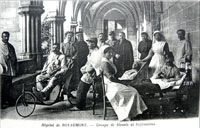
|
Before the First World War all women had been denied the right to vote in General Elections and many women (depending on their marital status and situation) were also denied the right to vote in local elections. They were barred from employment in many professions and industries and, where they did gain employment, pay and conditions were not equal with those of their male counterparts. Women in the workplace were frequently seen as a threat to the established order and relegated to the status of 2nd class citizens.
There is a section, in the more general history of Oldham's history, devoted to the struggle for Women's Suffrage: HERE
Compared to Germany, Austria and France, Britain had a very small regular army and had relied heavily on her superior navy and seapower in earlier conflicts. The First World War changed all that. As soon as it was realised that this war would be different, two factors were immediately apparent; many more men would be needed for the battlefields and there would be a corresponding increase in the need for services, armaments and necessary equipment. As enormous numbers of men answered the call to enlist in the armed forces, the workforce was seriously depleted creating a desperate shortage of workers to service the needs of a country at war on foreign soil.
Women stepped forward. They weren't exactly welcomed with open arms by either industries or the government but their own persistence and the crushing need for workers both on the home front and abroad, allowed women into occupations previously denied to them. They still weren't employed on equal terms with the men!
We now know that in WW1 women worked in some of the most dangerous, and physically exhausting situations we can imagine, both at home and on battlefields. The women left at home, and the Women's Suffrage movement, threw themselves into the business of supporting the men in the forces and those families left behind, in whatever ways they could.
Home Front
~~~~~~~~~~~~~~~~~~~~~~~~~~~~~~~~~~~~~~~~~~~~~~~~~~~~~~~~~~
|
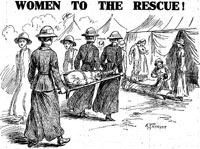
|
|
Dr. Catherine Payne
Impatient with the War Office's refusal to send women doctors to the battle zones, Mrs. St Clair Stobart, who had already organised a hospital and staff for both the French, and Belgian, Red Cross, responded to a plea for help from the Serbian Relief Fund. One of the doctors joining Mrs. Stobart's Flying Hospital, going to Serbia, was Dr. Catherine Payne, a member of the 'Oldham Society for Women's Suffrage', who held the post of Resident Assistant Medical Officer, at the Oldham Poor Law Institution.
Read her story HERE (opens in a new window)
|
~~~~~~~~~~~~~~~~~~~~~~~~~~~~~~~~~~~~~~~~~~~~~~~~~~~~~~~~~~
THE ROLE OF WOMEN IN WW1 - a selection of images from the Imperial War Museum Collections
click on each image to see a larger copy, and more descriptive information, on the IWM website.
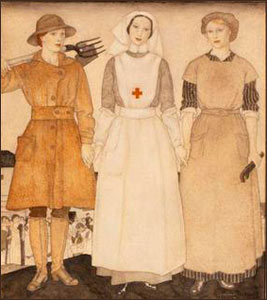
'The Sisters'
Three women stand hand in hand, each dressed in a different uniform illustrating the variety of roles women have in wartime. From left to right there is a member of the Land Army, a nurse, and a munitions worker. In the background are more women workers.
|
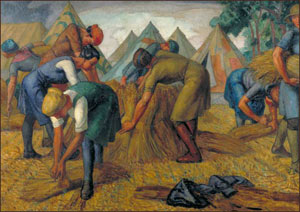
A group of women land workers gathering flax, which they tie into bundles and stack in a pile. Their camp of bell tents lies in the background next to a group of trees.
|
-th.jpg)
Women Working in a Gas Retort House: South Metropolitan Gas Company, London
The interior view of a gasworks showing the retort process. Several women dressed in dark overalls stand at work on the floor of the gasworks. The focal point is the clouds of grey smoke and yellow flames emitted from the wall on the left of the painting.
.
|
-th.jpg)
Members of the QMAAC : at work in the cookhouse, RAF Camp, Charlton Park
The interior of a cookhouse, with five women of the Queen Mary's Auxiliary Army Corps at work around large cookers.
|
-th.jpg)
A Land Girl Ploughing
A scene showing two grey horses harnessed to a plough being driven by a Land Girl, moving from right to left of the composition. Beyond the girl is a view of the distant countryside. A storm is brewing in the grey sky above their heads
|
-th.jpg)
Congleton War-Working Party
Within the interior of a large room numerous women sit working at tables, predominantly engaged in sewing and working with textiles. In the left foreground a few women are at work at sewing machines. On the right two women, one of whom is dressed grandly wearing a large black hat, are standing and overlooking the work.
|
-th.jpg)
National Service Women Clerks Wanted at Once
The main image depicts three female National Service volunteers standing together on a quay side, waiting to board a steam ship moored in the background left. Another steam ship and a tugboat are visible in the background right. A smaller image depicts the crest of the National Service Department's Women's Section, which includes a depiction of Winged Victory holding a circular shield. text: W.52 NEW SERIES NATIONAL SERVICE WOMEN CLERKS WANTED AT ONCE FOR SERVICE IN FRANCE WITH THE BRITISH ARMY For Conditions of Service and Application Forms APPLY WOMEN'S SECTION NATIONAL SERVICE DEPARTMENT, ST. ERMIN'S WESTMINSTER, S.W. 1. GWE
|
-th.jpg)
For King and Country
The interior of a munitions factory with female workers making shells. Each is dressed in beige coloured overalls with a cloth bonnet on her head On the right of the composition the women work alone at machinery; and on the left they stand at work benches in groups. In the centre of the composition a woman walks towards the viewer holding a shell in her hands.
|
-th.jpg)
The Workroom of the Gerrard's Cross War Hospital Supply Depôt
an interior scene of a room with nurses working at two long tables. The image is dominated by the greys and whites of their uniforms, and the bandages they are rolling. The nurses sit and stand, everyone absorbed in their work.
|
-th.jpg)
Women's Canteen at Phoenix Works, Bradford
The interior of a canteen filled with female workers. There is a counter to the right of the composition, and tables occupied with women in overalls and cloth caps to the left. There is a queue at the counter, with several women holding large white cups. In the centre two women walk arm-in-arm towards the viewer, and next to them another stands looking out in the same direction.
|
-th.jpg)
Miss Penrose, MM, QMAAC Administrator; Superintending French labour on camouflage at Aire
The interior of a large shed and a group of eleven women working on wooden frames holding camouflage netting. The women are tying on green rags which are stored in baskets in the centre area. They are supervised by another woman in a grey QMAAC uniform, who is standing on the left and holding a roll of paper. Above the workgroup a large piece of grey green material hangs from the rafters.
.
|
-th.jpg)
Help Our Women War Workers
The emblem of the YWCA is positioned in the upper left. image: three-quarter length depictions of two members of Queen Mary's Army Auxiliary Corps, their heads turned to face the viewer. They wear overcoats and hats, and gesture towards a well lit YWCA hut in the background. Behind the hut, trees and the moon are visible against a dark blue night sky.
The Women's Army Auxiliary Corps was formed in January 1917 and recruited the first women into the British Army to serve in a non-nursing capacity. The WAAC provided catering, storekeeping, vehicle maintenance and clerical duties for the British Army, freeing more men to take up combat roles. In 1918 Queen Mary became patron and the corps was renamed Queen Mary's Army Auxiliary Corps. Over 57,000 women enrolled in the WAAC/QMAAC during the First World War and though not given full military status, often worked close to the frontline. Three Military Medals were awarded to members for gallantry. The QMAAC was eventually disbanded in September 1921.
|
-th.jpg)
Scene at a Clyde Shipyard. (Messrs Beardmore & Co)
A view of the interior of a shipyard machine shed. Workers dressed in brown overalls work at lathes and heavy machinery.
|
-th.jpg)
Christmas Day in the London Bridge YMCA Canteen:
HRH Princess Helena Victoria, Chairman of the Ladies' Auxiliary Committee of the YMCA is standing by Mrs Norrie, CBE, Superintendant of the canteen. Miss Ellen Terry is sitting by the table.
The interior view of a canteen with flags of the allied countries hanging like bunting along the top of the room. On the right the room is crowded with soldiers awaiting their meal. In the foreground and left are women preparing to serve them. The female guests of honour, the princess and famous actress, stand and sit in the foreground.
|
-th.jpg)
Vegetable Day
The main image depicts three women carrying an injured civilian on a stretcher during an air raid on a city. Behind the images are nine Allied flags (American, British, French, Russian, Belgian, Serbian, Japanese, Romanian and Italian). text: W.A.F. (WOMEN'S AUXILIARY FORCE REGD.) PATRONESS: H.R.H. PRINCESS ARTHUR OF CONNAUGHT PRESIDENT: THE VISCOUNTESS FRENCH VEGETABLE DAY WEDNESDAY JULY 11T.H. 1917. FUNDS WANTED TO 'CARRY ON' FOR:- CANTEENS FOR SOLDIERS AND SAILORS; COMFORTS' FUND APPROVED BY THE WAR OFFICE; GROWING VEGETABLES FOR HOSPITALS,AND HERBS FOR MEDICINAL USE; ENTERTAINING THE WOUNDED; CONCERT PARTIES FOR THE TROOPS; HELPING IN HOSPITALS AND IN AIR RAIDS.
|
-th.jpg)
The Ladies' Army Remount Depôt, Russley Park, Wiltshire, 1918
A group of women riders exercising pairs of horses. They break into a trot along an unsurfaced road. In the background the hills and fileds roll off into the distance.
|
-th.jpg)
The Acetylene Welder 'Britain's Efforts and Ideals'; Making Aircraft
Two women are welding at work benches with vices. A cyclinder stands by the side of the bench. They are wearing scarves, goggles and aprons but their hands and arms are bare.
|
-th.jpg)
Shop for Machining 15-inch Shells: Singer Manufacturing Company, Clydebank, Glasgow, 1918
The interior view of a munitions factory showing the production of 15 inch shells by women factory workers. There are winches hanging from the ceiling and large steel shell cases sitting on wooden trolleys in the centre of the image. There are several women standing amongst the machinery, one to the left, and another on the right.
During the First World War, the factory switched production to armaments. The painting shows both the size of the building and the weight of the shells.
|
.jpg)
Concerts Daily at the Floral Fête
|
-th.jpg)
An Aircraft Assembly Shop, Hendon
The interior view from an elevated position showing the shop-floor of an aircraft assembly factory. The aircraft are seen in various stages of assembly to the left and right of the image. In the centre are lines of workbenches and a range of different factory personnel.
The scene is the interior of the Aircraft Manufacturing Company erecting shop with DH 9 planes in various stages of production. Air power became a critical factor in World War One and Hendon, with its large training school, a focus for aircraft production. On the left, the fuselages are being constructed to be run up the ramp at the back of the factory into the upper shop. There the machines are fitted out and given individual numbers and markings. Workers are grouped together according to trades.
|
.jpg)
Lady Henry's Crêche, Woolwich
The interior of a room lined with children's cots, occupied by very young children and babies. A group of nurses tend the babies in the background. A play-pen filled with toddlers stands in the foreground.
The Ministry of Munitions introduced a subsidy from 1917 (when they would pay 75% of the construction cost of new nurseries and a payment of 7d per day per child placed there).
|
-th.jpg)
Ladies Emergency Committee of the Navy League
|
.jpg)
Three women glass workers pack a "government order for 1 million lamp bulbs" at a warehouse somewhere in Britain. Two of the women crouch down to pack boxes, whilst a third is framed in the doorway as she enters the warehouse, carrying a box full of light bulbs. The ground is lined with straw to prevent breakages.
|
-th.jpg)
WOMENS SERVICE IN THE ROYAL FLYING CORPS AND THE WOMENS ROYAL AIR FORCE 1914 - 1918
WRAF aircraft cleaners working on Sopwith 1½ Strutter biplanes.
|
-th.jpg)
Women's Auxiliary Army Corps: WAACs and convalescent soldiers playing cricket in the camp at Etaples, France.
1 May 1918.
|
-th.jpg)
QMAAC Cookhouse, Rouxmesnil, 1919
The interior of a Queen Mary's Auxiliary Army Corps cookhouse, which appears to be housed in a Nissen hut with a curved ceiling. There are large cookers with chimneys going up to the ceiling in the centre of the room. Six QMAAC women are shown at work in the cookhouse.
|
-th.jpg)
The Women's Emergency Canteen, Gare du Nord, Paris, 1919
The interior of a large, dimly-lit canteen full of tables and chairs and largely populated by nurses in uniform. In the centre is a pillar, which has national flags hanging from it towards the ceiling.
|
-th.jpg)
Women's Auxiliary Army Corps: WAACs and convalescent soldiers playing basketball in the camp at Etaples.
|
![Five QMAAC [Queen Mary's Army Auxiliary Corps] cleaning silver for No. 1 Wing Officers Mess at Harfleur.](../images/large-(28)-th.jpg)
Five QMAAC [Queen Mary's Army Auxiliary Corps] cleaning silver for No. 1 Wing Officers Mess at Harfleur.
|
-th.jpg)
Women Gas workers carrying 1 cwt. sack of coke, South Metropolitan Gas Co., 709, Old Kent Road, June 1918
|
-th.jpg)
Women Gas workers carrying 1 cwt. sack of coke, South Metropolitan Gas Co., 709, Old Kent Road, June 1918
|
-th.jpg)
The Bakeries, Dieppe, 1919
A view along the length of the interior of a large bakery. Female workers, wearing caps covering their hair, can be seen at work. One woman on the right appears to be working on a large mound of dough on a table.
|
-th.jpg)
Q.M.A.A.C. in Cookhouse No. 1. Base Remounts. Rouen.
|
-th.jpg)
Q.M.A.A.C. Camp No.1. Orderly Room. Miss Shepherd. Etaples.
|
-th.jpg)
Women Putting Anti-fouling Paint on the Bottom of an ML Leith
A group of women at work painting the hull of a Royal Navy Motor Launch with anti-fouling paint. The vessel is mounted on large metal supports in a dockyard so that the women have full access to the hull. It is shown port side on and a man in uniform stands in the foreground. There is a large crane in the background to the right and parts of the superstructure of a dazzle painted warship are visible to the left. The ground is covered in snow.
|
-th.jpg)
A patient, his arm in a weighted arm rest, and nurse on the verandah at the Duchess of Westminster's Convalescent Red Cross No 1 Hospital at Le Touquet.
|
-thjpg.jpg)
Air raid damage done at the St John's Ambulance Brigade Hospital at Etaples, May 1918. Among those inspecting the damage are some Salvation Army female workers.
|
-th.jpg)
A Red Cross Train, France
Wounded British soldiers are transferred from a motor ambulance to a Red Cross train, which is on a railway amongst trees. Orderlies and a QAIMNS nurse lift a stretcher onto the train, with another nurse looking on. Other British soldiers stand around watching the scene
|
|
Images and text information courtesy of the Imperial War Museum website
|
If you have Oldham and District items that we can include on our website, PLEASE visit the information page to find out how you can help.
|

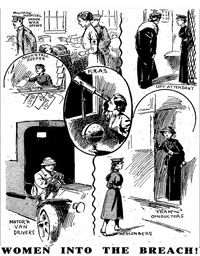

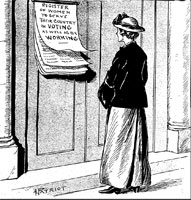

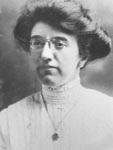


-th.jpg)
-th.jpg)
-th.jpg)
-th.jpg)
-th.jpg)
-th.jpg)
-th.jpg)
-th.jpg)
-th.jpg)
-th.jpg)
-th.jpg)
-th.jpg)
-th.jpg)
-th.jpg)
-th.jpg)
-th.jpg)
.jpg)
-th.jpg)
.jpg)
-th.jpg)
.jpg)
-th.jpg)
-th.jpg)
-th.jpg)
-th.jpg)
-th.jpg)
![Five QMAAC [Queen Mary's Army Auxiliary Corps] cleaning silver for No. 1 Wing Officers Mess at Harfleur.](../images/large-(28)-th.jpg)
-th.jpg)
-th.jpg)
-th.jpg)
-th.jpg)
-th.jpg)
-th.jpg)
-th.jpg)
-thjpg.jpg)
-th.jpg)